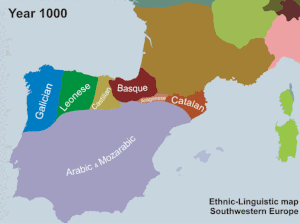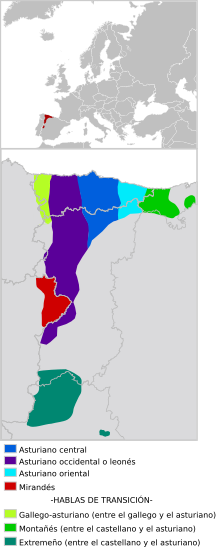Asturleonese language
| Asturleonese | ||
|---|---|---|
|
Spoken in |
Spain , Portugal | |
| speaker | 450,000 (?) | |
| Linguistic classification |
|
|
| Language codes | ||
| ISO 639 -1 |
- |
|
| ISO 639 -2 |
ast |
|
| ISO 639-3 |
ast |
|
The Asturleonesian language or Asturian- Leonese language (astur./leones. Asturllionés , span. Asturleonés ) is an Ibero-Romance language group spoken in northwestern Spain and neighboring areas of Portugal . It includes Asturian in most of the Asturias region , Leonese in parts of the provinces of León , Zamora and Salamanca, and Mirandese in the Miranda do Douro area of Portugal. In a broader sense, the Extremaduric language of Extremadura is also sometimes included.
Language names
The term Asturleonesian or Asturian-Leonesian (astur./leones. Asturllionés , span. Asturleonés ) comes from Romance linguistics and is used in scientific publications as an overarching term for the entirety of the related varieties, but is not used as a self-term.
In Asturias , the varieties there are generally referred to as Asturian (astur. Asturianu , span. Asturiano ) or as bable , the latter term being widely used in colloquial terms, but perceived by some as pejorative and therefore rejected. In circles calling for the official recognition of the language in Asturias, the name Asturian is used almost exclusively .
In the area of the provinces of León , Zamora and Salamanca , on the other hand, the term Leonese (leones. Llïonés or Spanish. Leonés ) is used for the varieties there .
In Miranda do Douro , the local variety is called Mirandés .
classification
Asturian-Leonese is part of a dialect continuum that encompasses all the Ibero-Romance varieties in the north of the Iberian Peninsula . In addition to Galician - Portuguese , Castilian (Spanish) , Aragonese and Catalan, it forms one of the five Romance dialect groups of the Iberian Peninsula that still exist today, which, according to the current state of historical and comparative Romance linguistics , arose directly from the local Vulgar Latin - in contrast to the im Varieties spoken in the south of the peninsula that arose from the language forms brought there by the Reconquista.
The Asturleonese varieties pass into the Castilian (Spanish) ones in the east, southeast and south, and into the Galician and Portuguese ones in the west . Overall, the similarities with Spanish are greater than those with Galician-Portuguese.
The dialectal structure within Asturleonese only partially follows the primarily sociolinguistically motivated distinction between Asturian , Leonese and Mirandesian . Asturian can be divided into numerous sub-dialects, with the isoglosses running in north-south direction mostly being continued in Leonese. In some respects, Mirandesian has a special position, which, in addition to its peripheral location, is also due to the separating effect of the Spanish-Portuguese border.
In the south, in the varieties of Extremadura , the Extremeño , in addition to Castilian, clear Asturleonese elements can be detected without being clearly attributed to Asturleonese; the northern dialects are closest to it, the central and southern dialects, on the other hand, can best be assigned to Andalusian Spanish.
distribution
Asturian-Leonese is spoken in most of the Asturias region; The exception is the area on the border with Galicia , where transitional dialects between Asturian and Galician are spoken. However, especially in the larger cities, Castilian (Spanish) has recently spread not only as a second but also as a first language, so that part of the population there no longer speaks Asturian. In total, around 450,000 people (44.4% of the total population) speak Asturian in Asturias.
Asturian-Leonese is also spoken in the north and west of the Spanish province of León and in the west of the Spanish provinces of Zamora and Salamanca , which were once part of the Kingdom of León .
Finally, Mirandesian (Mirandês), which goes back to Asturian-Leonese, is spoken in the Miranda do Douro district and in some villages in the neighboring districts in north-east Portugal .
For some varieties in the west of Asturias and the province of León, as well as in the east of the Galician province of Ourense, it is disputed whether they should be assigned to the Asturian-Leonese or the Galician.
Sociolinguistics
The native speakers of Asturleonese generally speak their local variety.
Due to numerous linguistic similarities with Spanish on the one hand and the fact that there was no standardized Asturian-Leonese written language for a long time, but instead Spanish was used in this function, the Asturleonese varieties were generally regarded as dialects of the Spanish language in the older Romance languages . This also corresponded to the previously widespread self-perception of the speakers of their language as somehow "corrupted" Spanish.
In the Asturias region , a written language standard for Asturian based on the dialects of Central Asturias has been drawn up since the 1970s and 1980s . The requirement for official recognition of the language has so far only been met to a limited extent (in the school system and at the local level in some municipalities). However, the official language of the Asturias region is only Spanish. Some preschool and elementary schools use the language as a medium of instruction. In the primary and secondary levels, Asturian is offered as an elective.
In Portugal , the Mirandês in the area of Miranda do Douro is the local official language along with Portuguese.
literature
- Günter Holtus , Michael Metzeltin , Christian Schmitt (Hrsg.): Lexicon of Romance Linguistics . 12 volumes. Niemeyer, Tübingen 1988-2005; Volume VI, 1: Aragonese / Navarre, Spanish, Asturian / Leonese. 1992.
Web links
- academiadelallingua.com
- Las lenguas románicas estándar. Historia de su formación y de su uso, Oviedo, 2004
- exunta.org
- asturies.com
- fueyallionesa.tripod.com Leonese-language weekly newspaper

